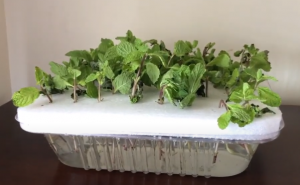What is Hydroponics System and how does it work?

Hydroponic crops consume almost 90% less water than that of a traditional method.
Hydroponic is the fastest growing sector of agriculture, and it could dominate food production very well in the future. Let’s find out why hydroponic is a very beneficial method.
Introduction
Hydroponics is a method of growing plants in nutrient-fortified water, instead of in soil. It can also be termed as aquaculture or soilless culture. This technique is first introduced by Greek. The hydroponic method came in practice due to various problems faced by people due to climate-related events, urbanization, and natural disaster. The hydroponic method is gaining popularity all over the world because of efficient resources management as well as quality food production.
Types of Hydroponic system
Wick hydroponic system
This is one of the most simple hydroponic systems. It is cheap, manageable, and effortless compared to other active hydroponic systems as this system doesn’t involve any moving parts to work at all. The wicks are there to connect the growing medium and nutrients solution at either end. They transport nutrients from the solution reservoir into the growing medium such as perlite, coco coir, etc.

Water culture hydroponic system
It is an active hydroponic system, and compared to other active hydroponic systems it is one of the easiest/manageable. This approach involves plants floating on top of the solution with some sort of the medium in between so the plants don’t drown. This results in their roots dangling in a nutrient solution. An air pump is required to oxygenate the solution for the proper growth of the plant.


Nutrient Film Technique
This approach requires a constant flow of nutrient solution in the growing tub which flows through the tip of the roots with the help of a pump in the reservoir. The solution simply drains into the reservoir. Plants are generally suspended in the air just as in Aeroponics, so no growing mediums are required which minimizes the cost. There is also no need for oxygenating the solution since the plants are already suspended in the air. Since this method requires a constant flow of nutrient solution, any power outage can disrupt the process.

Ebb and flow
Ebb and flow are very much similar to the N.F.T approach as this also involves drowning the tip of roots in the nutrient solution except the nutrient solution is pumped between specific time intervals in the growth tray. The solution drains back into the reservoir at a slow pace. This system requires a pump hooked to a timer.

Aeroponics
It is one of the simple hydroponic systems which is similar to a Nutrient film technique. In this method, the roots of plants are mostly suspended in air and are misted with a nutrient solution. There are two methods to get the solution to the exposed roots. The very first method involves a fine spray nozzle to mist the roots of the plants whereas another method uses a pond fogger. Comparatively, the Aeroponics system can be considered as an expensive method.

Drip System
It is one of the simple and common hydroponic systems and is used mostly for commercial purposes. In this method, roots of plants are suspended in a solution of nutrient-rich, oxygenated water. Different slow draining mediums such as rock wool, coconut coir or peat moss, etc. should be used. Generally, This method is favorable to use on a large scale rather than small gardens.

Hydroponics at home
You can grow different plants in your home or indoor by building your own DIY hydroponic grow system. There are various DIY hydroponic system plans. Simple bucket hydroponic system in one of those plans which is absolutely a beginner material.

Simple Bucket Hydroponic System:
It is one of the most simple hydroponic systems. For this setup, a 5-gallon bucket and some growing mediums like coco-pit or perlite-vermiculite along with some nutrient mix is required.
Capillary action is needed to move nutrients to the plant roots which is achieved using growing media. Water the plants and their roots manually.
Difficulty level: Beginner (1/5)
Advantages of hydroponics
- One of the most efficient ways of farming.
- Plants can be grown under any weather conditions provided that a hydroponic system is already in place; results in a growth rate much better than of traditional farming.
- Improves harvest quality and increases production by 3 to 4 folds or even more.
- No need to worry about any pests and diseases affecting the plants.
- Saves water.
- Nutrients are not wasted.
- No need to worry about spraying insecticides and pesticides affecting the plants.
Disadvantages of Hydroponics
- The hydroponic system requires a lot of time as well as commitment.
- Different knowledge and experiences should be gained.
- Generally, the Hydroponic system is expensive.
- Waterborne diseases can easily spread from one plant to another within an artificial environment.
- System failure as well as other threats are likely to occur.
Interesting fun facts of Hydroponics
- Hydroponic crops consume almost 90% less water than that of a traditional method.
- No soil is required in the Hydroponic system.
- No seasonal disturbances while growing plants.
- Plants grow faster and larger in the Hydroponic system.
- In Hydroponic, crops don’t require any pesticide or any other chemicals for growing properly.





excellent info on moringa plants, where can I purchase seeds to plant it?
The best place is amazon at your location. Try checking some agro stores around you. Let us know for more questions.
A very interesting article. I thought they were part of pilea peperomioids. These nasturtium grow like weeds where I live in southern part of South Africa. The only problems are snails. They are hardy and face drought conditions well. We don’t get frost. I love them xx
Thank you for your comment. I really appreciate it. Please be with us and help us share with your friends and family.
You are so right about choosing well drained soil for planting the grapes. It worked great when we tried.
Thank you for your comment. We appreciate it.